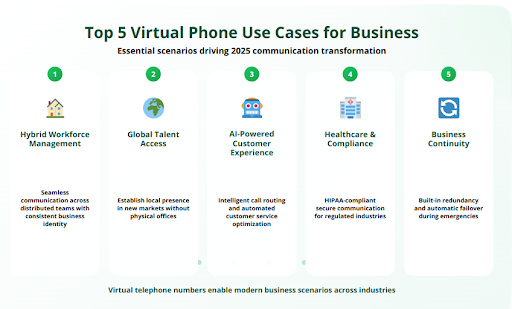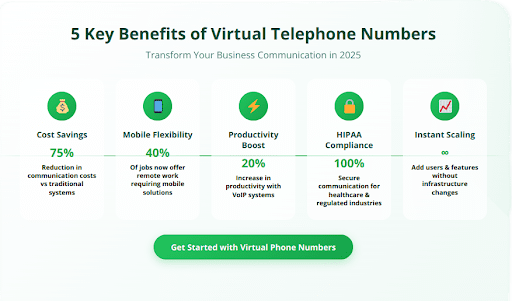Virtual telephone numbers are revolutionizing business communication by enabling remote work flexibility and professional presence without traditional phone constraints.
- 40% of jobs now offer remote work options, driving demand for cloud-based communication solutions
- Businesses can save up to 75% on communication costs through virtual telephone number adoption
- Modern use cases include hybrid workforce management, global talent access, and AI-powered customer routing
- Key scenarios range from HIPAA-compliant healthcare communication to real-time customer service optimization
The right virtual telephone number for business transforms communication from a constraint into a competitive advantage.
The business communication landscape has fundamentally shifted in 2025, with traditional desk phones becoming as obsolete as fax machines once were. Virtual telephone numbers for business now serve as the backbone of modern enterprise communication, enabling everything from seamless remote work to sophisticated customer service operations. According to Robert Half’s latest research, 40% of jobs now offer some amount of remote work, driving unprecedented demand for flexible communication solutions. Understanding which virtual telephone number solution best fits your business requires examining current use cases and emerging scenarios that define today’s communication needs.
What is a Virtual Telephone Number for Business?
A virtual telephone number for business operates through internet-based Voice over Internet Protocol (VoIP) technology rather than traditional phone lines. Unlike conventional landlines tied to specific physical locations, virtual numbers exist in the cloud and route calls to any internet-connected device you designate. This flexibility allows employees to answer business calls on smartphones, laptops, or desk phones from anywhere with reliable internet access.
The technology transforms how businesses handle communication by separating phone numbers from physical infrastructure. When someone dials your virtual telephone number for business, the call travels through your provider’s servers and routes to predetermined destinations based on your configured rules. You might direct calls to different team members during business hours, route after-hours calls to voicemail, or forward international calls to local representatives.
Virtual telephone numbers maintain the same functionality as traditional business lines while adding layers of intelligence and flexibility. Callers experience no difference in call quality or connection reliability, but your business gains unprecedented control over call management, routing, and analytics.
Top 2025 Business Use Cases for Virtual Telephone Numbers
1. Hybrid Workforce Management
Remote and hybrid work models have become permanent fixtures in the business landscape, with statistics showing that flexible work arrangements continue to dominate hiring practices. Virtual telephone numbers enable seamless communication across distributed teams by providing consistent business identity regardless of employee location.
Companies use virtual numbers to maintain professional presence while supporting work-from-home policies. Sales representatives can make calls from home offices while displaying the company’s main number on caller ID. Customer service teams spread across multiple time zones can share the same business line, ensuring continuous coverage without revealing personal contact information.
2. Global Talent Access and International Operations
Businesses expanding beyond geographical boundaries leverage virtual telephone numbers to establish local presence in new markets without physical offices. A software company based in Austin can obtain New York and Los Angeles numbers to serve clients in those markets, creating the impression of local representation while maintaining centralized operations.
International use cases include providing customers with local numbers to call, eliminating expensive international dialing fees. E-commerce businesses use this approach to offer localized customer support, while consulting firms provide clients with familiar area codes that encourage engagement.
3. Enhanced Customer Experience Through AI Integration
Modern virtual telephone number systems incorporate artificial intelligence to optimize customer interactions. AI-powered call routing analyzes caller history, time of day, and available staff to direct calls to the most appropriate representatives. This technology reduces wait times and improves first-call resolution rates.
Intelligent scenarios include automatically routing technical support calls to certified specialists, directing sales inquiries to representatives familiar with specific products, or escalating high-value customer calls to senior staff. These systems learn from interaction patterns to continuously improve routing decisions.
4. Healthcare and Compliance-Critical Communication
Healthcare organizations, legal firms, and financial services require secure communication solutions that meet strict regulatory requirements. Virtual telephone numbers designed for these industries include HIPAA compliance features, encrypted calling, and detailed audit trails. Healthcare providers benefit from secure communication solutions that protect patient information while enabling efficient telehealth operations.
Telemedicine scenarios involve healthcare providers using virtual numbers to conduct patient consultations while maintaining privacy and security standards. Legal practices use secure virtual lines for confidential client communications, while financial advisors leverage encrypted channels for sensitive planning discussions. These compliance-focused use cases demonstrate how virtual telephone numbers for business serve specialized industries with enhanced security requirements.
5. Real-Time Business Continuity
Natural disasters, power outages, and infrastructure failures can cripple traditional phone systems, but virtual telephone numbers provide built-in redundancy. When physical offices become inaccessible, calls automatically route to backup locations or remote workers’ devices.
Emergency scenarios include redirecting all business calls to key personnel’s mobile devices during office closures, maintaining customer service operations during relocations, or scaling communication capacity during peak demand periods without installing additional hardware.
Essential Features for Modern Business Communication
Advanced Call Routing and Intelligence
Sophisticated routing capabilities distinguish professional virtual telephone number systems from basic consumer services. Time-based routing directs calls to different destinations during business hours versus after-hours periods. Skills-based routing connects callers with representatives who possess specific expertise relevant to their needs.
Geographic routing scenarios enable businesses to provide localized service by connecting callers to representatives in their time zones or regions. Priority routing gives VIP customers immediate access to senior staff, while overflow routing prevents busy signals by distributing calls across available team members.
Integration with Business Applications
Modern virtual telephone numbers integrate seamlessly with customer relationship management (CRM) systems, help desk software, and productivity applications. When calls arrive, relevant customer information automatically appears on representatives’ screens, enabling personalized service from the first interaction.
Integration scenarios include logging call details directly into CRM records, triggering automated follow-up workflows based on call outcomes, and synchronizing contact information across multiple business applications. These connections eliminate manual data entry and ensure consistent customer experiences.
Mobile-First Functionality
Business virtual phone numbers must support mobile-first operations where smartphones serve as primary communication devices. The global mobile VoIP market reached $44.99 billion in 2023 and is projected to grow at a 12.9% CAGR through 2030, driven by increasing smartphone adoption and remote work demands. Native mobile applications provide full feature access including call management, voicemail transcription, and team messaging capabilities.
Mobile scenarios encompass field service representatives accessing company directories while visiting customer sites, sales teams managing leads through mobile CRM integration, and executives maintaining full communication control while traveling internationally. The shift toward mobile-first business communication reflects broader workplace transformation where HIPAA-compliant solutions enable secure communication across healthcare, legal, and financial services industries.
Analytics and Performance Monitoring
Comprehensive analytics transform business communication from reactive to proactive management. Call volume analysis reveals peak demand periods, helping businesses optimize staffing schedules. Call duration metrics identify training opportunities, while missed call reports highlight capacity constraints.
Performance scenarios include tracking sales team call activity to identify coaching opportunities, monitoring customer service response times to maintain quality standards, and analyzing geographic call patterns to guide market expansion decisions.
How Virtual Numbers Support Remote Work Scenarios
Maintaining Professional Presence
Remote work scenarios require maintaining professional communication standards regardless of employee location. Virtual telephone numbers enable home-based workers to make outbound calls displaying company information rather than personal numbers. This consistency reinforces brand identity and protects employee privacy.
Professional scenarios include customer service representatives working from home while appearing to call from corporate headquarters, sales teams maintaining unified caller ID across distributed locations, and executive assistants managing multiple calendars from remote offices.
Collaborative Communication Workflows
Virtual telephone number systems support complex collaboration scenarios that traditional phone systems cannot accommodate. Team members can share access to business lines, transfer calls seamlessly across devices, and participate in conference calls using consistent business identity.
Collaboration scenarios encompass project teams accessing shared voicemail boxes for client communications, multiple employees monitoring customer service lines during peak periods, and managers supervising call quality across remote teams through monitoring features.
Scalable Communication Infrastructure
Remote work demands scalable communication solutions that grow with business needs without requiring physical infrastructure changes. Virtual telephone numbers enable businesses to add new team members, expand to new markets, or increase capacity during busy periods through simple online configuration.
Scalability scenarios include seasonal businesses ramping up communication capacity during peak periods, rapidly growing startups adding team members across multiple locations, and established companies launching new product lines with dedicated support numbers. The flexibility of virtual telephone number systems allows organizations to respond quickly to changing business demands while maintaining consistent professional communication standards.
Cost Analysis and ROI Considerations
Cost Reduction and Infrastructure Elimination
Businesses adopting virtual telephone numbers eliminate substantial costs associated with traditional phone systems. According to Tech.co’s analysis, companies can save up to 75% on communication costs when switching to virtual number systems. Monthly savings include PBX maintenance fees, hardware replacement costs, and expensive carrier contracts with long-term commitments.
Cost reduction scenarios involve eliminating desk phone purchases for new employees, avoiding PBX system upgrades that traditional systems require, and reducing carrier fees through consolidated internet-based communication. G2’s research shows that small businesses save an average of 68% by switching to usage-based virtual phone plans, with many organizations seeing returns on investment within the first quarter of implementation.
Enhanced Productivity and Operational Efficiency
Virtual telephone number systems increase operational efficiency through automation and intelligent routing. Research from G2 demonstrates that VoIP systems can increase company productivity by up to 20% by enabling calls from anywhere, while employees save an average of 32 minutes daily through streamlined communication workflows.
Time savings accumulate through reduced call handling complexity, automated voicemail transcription, and integrated communication workflows that eliminate manual processes. Advanced features include HD voice quality, call recording, and seamless integration capabilities that support modern business operations across multiple devices and locations.
Efficiency scenarios include customer service teams resolving issues faster through integrated CRM information, sales representatives spending more time selling rather than managing communication logistics, and managers accessing real-time performance data for immediate optimization decisions.
Enhanced Revenue Generation
Professional communication capabilities enabled by virtual telephone numbers directly impact revenue generation. Improved customer service leads to higher retention rates, while expanded market reach through local presence creates new sales opportunities.
Revenue scenarios encompass increased sales conversion rates through professional communication presentation, expanded market penetration through local number establishment, and improved customer satisfaction leading to positive referrals and repeat business.
Implementation Best Practices
Strategic Planning and Assessment
Successful virtual telephone number implementation begins with comprehensive assessment of current communication needs and future growth plans. Organizations should evaluate existing phone usage patterns, identify communication pain points, and establish measurable improvement goals.
Planning scenarios include conducting communication audits to understand current costs and usage patterns, surveying team members to identify desired features and capabilities, and establishing implementation timelines that minimize business disruption while maximizing benefits.
Staff Training and Change Management
Employee adoption determines virtual telephone number implementation success. Comprehensive training programs should cover system features, best practices for professional communication, and troubleshooting common issues that remote workers might encounter.
Training scenarios involve hands-on workshops for sales teams learning CRM integration features, customer service representatives practicing call routing and transfer procedures, and managers understanding analytics dashboards for performance monitoring and team optimization.
Security and Compliance Configuration
Virtual telephone number systems require proper security configuration to protect business and customer information. Organizations should implement appropriate access controls, encryption settings, and compliance features relevant to their industry requirements.
Security scenarios include configuring multi-factor authentication for system access, implementing call recording retention policies that meet regulatory requirements, and establishing emergency communication procedures that maintain security while ensuring business continuity during crisis situations.
Transform Your Business Communication Today
Virtual telephone numbers for business represent more than technological upgrades; they enable fundamental transformation in how modern organizations communicate, collaborate, and serve customers. The use cases and scenarios explored throughout 2025 demonstrate that businesses adopting virtual communication solutions gain competitive advantages through improved flexibility, reduced costs, and enhanced customer experiences.
The statistics speak clearly: with 40% of jobs now offering remote work flexibility and businesses saving up to 75% on communication costs, virtual telephone number adoption has moved from optional to essential. Success with virtual telephone number implementation depends on selecting providers that understand modern business communication needs while offering scalable solutions that grow with your organization.
Phone.com provides comprehensive virtual telephone number solutions designed specifically for small and growing businesses, combining professional features with user-friendly management and reliable support. Our business virtual phone numbers include advanced features, mobile applications, and HIPAA-compliant options for regulated industries. Transform your business communication today by exploring Phone.com’s flexible virtual telephone number plans that support your current needs while scaling with your future growth.
FAQ
What’s the difference between a virtual telephone number and a traditional business phone? Virtual telephone numbers operate through internet connections rather than physical phone lines, providing greater flexibility and advanced features. Traditional business phones require dedicated hardware and physical installation, while virtual numbers work on any internet-connected device including smartphones, laptops, and computers.
How quickly can a business set up a virtual telephone number system? Most virtual telephone number providers offer immediate activation, with full system configuration possible within hours rather than weeks required for traditional phone installation. Basic setup involves choosing numbers, configuring routing rules, and downloading mobile applications, while advanced features can be activated as needed.
Do virtual telephone numbers work reliably for business-critical communication? Modern virtual telephone number systems provide enterprise-grade reliability with redundant infrastructure and failover capabilities. Many providers offer uptime guarantees exceeding 99.9%, surpassing traditional phone system reliability while providing built-in disaster recovery through automatic call routing.
Can virtual telephone numbers integrate with existing business software? Professional virtual telephone number systems offer extensive integration capabilities with CRM platforms, help desk software, and productivity applications. These integrations enable automatic call logging, contact synchronization, and workflow automation that improves efficiency and customer service quality.
What security measures protect virtual telephone number communications? Enterprise virtual telephone number systems implement multiple security layers including encryption for call content, secure authentication for system access, and compliance features for regulated industries. Many providers offer HIPAA compliance, SOC 2 certification, and other security standards that meet or exceed traditional phone system protections.
How do virtual telephone numbers support business growth and expansion? Virtual phone numbers scale effortlessly with business growth, allowing companies to add new team members, expand to new markets, or increase capacity without infrastructure investments. Businesses can obtain local numbers in new markets, support remote team expansion, and adjust communication capacity based on seasonal or growth demands.






